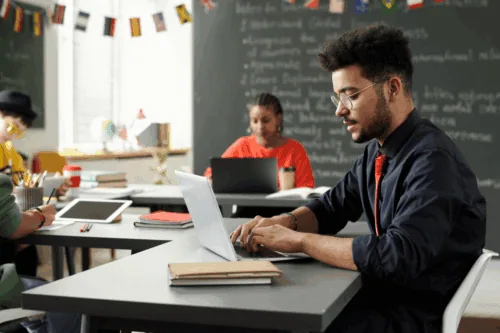Welcome to an enlightening journey through the American educational landscape, which promises opportunity but often presents hurdles, especially for minority students. With aspirations high but the path fraught with challenges such as the school-to-prison pipeline, racial discrimination, and inadequate resources, navigating this terrain requires understanding, support, and resilience.
This guide is crafted for you, the entry-level job seeker looking to thrive amidst these challenges. Here, we’ll explore the barriers that minority students face and, importantly, uncover strategies to overcome them. It’s a guide to empowerment, showcasing how you can transform obstacles into stepping stones toward success.
With Diversity Employment as your ally, we invite you on this journey. Discover the tools, resources, and communities ready to support you in carving out a fulfilling career path. Let’s unfold the pages together and step towards a future where education equips every student for the vibrant opportunities ahead, regardless of background.
The Real Struggle: Understanding the School-to-Prison Pipeline
First, let’s dive deep into what “school-to-prison pipeline” means.
There are a few key reasons:
- Strict Policies: Zero tolerance in schools often hits minority students the hardest.
- On-Campus Police: The presence of law enforcement can escalate situations unnecessarily.
- Lack of Support: Minimal guidance and counseling leave students without alternatives.
Moreover, this issue doesn’t just hurt individuals; it impacts whole communities. Here’s what you need to know:
- Minority students are more likely to face harsh discipline for the same actions their peers might receive a warning for.
- These policies don’t just disrupt their education. They can alienate students from the learning process altogether.
Now, what can we do about it? Understanding the challenges faced by minority students is the first step. From there, it’s about action. Advocacy and reform are crucial. Communities, educators, and lawmakers need to work together for change.
For more insights, check out (ACLU’s School-to-Prison Pipeline Explained). Also, discover how attitudes are shifting towards a more inclusive education environment with tips from Embracing Career Change as a Diverse Candidate.
This isn’t just an issue for the affected students and families – it’s a societal problem that requires our attention and action.
Facing Discrimination: Minority Students’ Daily Reality
For many minority students, discrimination is an everyday struggle that affects their learning journey. It comes in many forms, big and small, and profoundly impacts their educational experience.
Forms of Discrimination
Discrimination doesn’t just show up as direct insults or actions. It’s often woven into the very fabric of school life:
- Biased Expectations: Teachers might hold lower expectations for minority students, affecting motivation.
- Unequal Punishments: Studies reveal that for similar infractions, minority students receive harsher penalties.
- Exclusion in Curriculum: Lack of representation in textbooks and lessons can make students feel left out.
Addressing the Issue
Tackling discrimination means recognizing it in all its forms. Schools need policies that:
- Foster an inclusive environment where every student feels valued.
- Train staff to recognize and combat implicit biases.
- Ensure a curriculum that reflects diversity, giving every student a sense of belonging.
While resolving these issues takes time, understanding the problem is a starting point. To see the positive effects of diversity in education, check out how bilingualism is valued in the U.S. through Attitudes Toward Bilingualism in the United States.
Additionally, external resources like the Teaching Tolerance website offer tools and articles for educators to create more inclusive classrooms. Together, we can work towards a future where school discrimination is a thing of the past.
Limited Resources: The Battle for Quality Education
Imagine trying to learn with outdated books and crowded classrooms. For many, this is reality. Schools in minority neighborhoods often lack resources. This makes learning tough. But it’s not just about books or space.
What’s Missing?
- Old Books: Often, these schools use outdated materials.
- Big Classes: Too many students, not enough teachers.
- Few Counselors: Less guidance for future paths.
Next, consider tech. In today’s world, learning without computers or the internet is a big setback. Yet, this is common in these schools.
Making Changes
So, how can we help? First, raising awareness is key. Then, supporting policies that fund schools fairly is crucial. Also, donating supplies or time can make a difference.
If you’re curious about how to make classrooms better for everyone, check out Celebrating Culture: Festivals Around the World in February. This shows the power of understanding different cultures.
Lastly, visit the National Center for Education Statistics website for a deeper dive into educational equity. Together, we can ensure that every student has the tools they need to succeed.
Curriculum Concerns: The Need for Inclusion
Seeing yourself in what you learn matters. Yet, many textbooks neglect diversity. This leaves minority students feeling left out. Changing this starts with updating what we teach.
Why Inclusion Matters
- Boosts Engagement: Students are more involved when lessons reflect their backgrounds.
- Increases Understanding: Learning about different cultures promotes empathy among all students.
- Better Prepares for the World: A diverse curriculum equips students for a global society.
Thankfully, awareness is growing. Schools across the U.S. are adding diverse voices to their lessons. But, there’s still a long way to go.
Steps Forward
First, we should support educators in finding inclusive materials. Then, encouraging discussions on diversity in class is key. Finally, ensuring a wide range of stories and histories in the curriculum is vital.
To learn more about the influence of culture in education, explore Attitudes Toward Bilingualism in the United States. It highlights the value of embracing different backgrounds. Further, Edutopia offers resources for teachers to design inclusive curriculums.
Together, we can ensure our schools teach and honor every student’s story.
Fighting Back: The Role of Activism and Support
Change doesn’t happen on its own. It needs voices, action, and support. Thankfully, many are standing up for educational equity. They’re pushing for reforms that benefit minority students. But, there’s more to be done.
How to Get Involved
- Join Local Groups: Many communities have organizations focused on education reform.
- Support Policies: Vote for measures that promise equal resources for all schools.
- Spread Awareness: Sometimes, discussing the issues can open others’ eyes.
Also, supporting minority students directly makes a big impact. This can be through mentoring, tutoring, or even scholarships. Moreover, showing up at school board meetings matters. Your voice can push for necessary changes.
Organizations like the NAACP offer resources and ways to get involved in advocating for educational justice. By being active and supportive, we can build a fairer education system for everyone.
Making Progress: Steps Toward an Equitable Education System
Despite the roadblocks, progress is underway. Across the nation, people are working hard for an equitable education system. This means ensuring every student gets a fair chance at success regardless of their background.
Key Areas of Progress
- School Funding Reform: Efforts to redistribute resources more fairly are gaining traction.
- Inclusive Curriculums: More schools embrace lessons representing diverse cultures and histories.
- Reducing the School-to-Prison Pipeline: New approaches to student discipline aim to keep kids in classrooms, not courts.
Furthermore, technology plays a big role. Online learning platforms offer resources that were once out of reach for many. This helps bridge the learning gap.
Yet, there’s still a long way to go. The fight for an equitable education system continues. For those looking to join the cause, consider reading about the challenges faced by minority students. The Education Trust website is also a great resource for understanding and tackling education inequality.
We can all play a part. We can help build a system that serves everyone equally by supporting reforms and advocating for change.
Expert Tips: How to Support Minority Students
Helping minority students overcome educational barriers requires thoughtful action. Here are some expert tips for making a difference.
Boost Academic Success
- Offer Mentorship: Guidance from someone who’s walked the same path can be invaluable.
- Provide Resources: Access to extra tutoring or learning materials can level the playing field.
- Encourage Involvement: Getting involved in extracurricular activities boosts confidence and skills.
Furthermore, creating a supportive environment at home and school is crucial. It’s about showing that their community backs them, no matter what.
Cultivate a Sense of Belonging
- Ensure the curriculum includes diverse perspectives. This helps students see themselves in what they’re learning.
- Celebrate cultural diversity through events or clubs. This strengthens bonds between students from different backgrounds.
The NPR Education website frequently offers insights into the challenges and successes in education, particularly for minority students. Together, we can make a significant difference in their lives.
FAQs
Got questions? Here are answers to some common ones about supporting minority students and the school-to-prison pipeline.
How Can I Help Reduce Discrimination in Schools?
First, learn about it. Then, talk openly and support policies that foster inclusivity. Every action counts.
Why Is Diverse Curriculum Important?
It helps all students understand different cultures. Plus, it makes minority students feel seen and valued in their education.
Can Small Actions Really Make a Difference?
Yes, they can. Whether mentoring, donating, or advocating, small steps can lead to big changes. We all have a role.
Where Can I Find More Information?
For more on tackling the school-to-prison pipeline and supporting minority students, community resources and educational websites are great starting points. Also, talking to educators can offer insights and ways to get involved.
It’s about joining hands to create a better future for every student. Your support, no matter how small, matters.
Conclusion
The struggles that minority students face within the education system, from the school-to-prison pipeline to insufficient resources and discrimination, demand our immediate attention and action. We’ve explored the hurdles and, more importantly, the steps to build an equitable education system. However, change requires a collective effort.
Joining hands with organizations committed to this cause is crucial. By being a part of Diversity Employment, you’re not just seeking or offering employment; you’re joining a movement toward inclusivity and equality in every sector, including education. You can find diverse staffing jobs, resources, support networks, and opportunities to make a tangible difference here.
Let’s not just be bystanders to the injustices within our education system. Let’s be the change makers. Whether it’s through advocating for policy changes, supporting minority students directly, or spreading awareness, every action counts.




